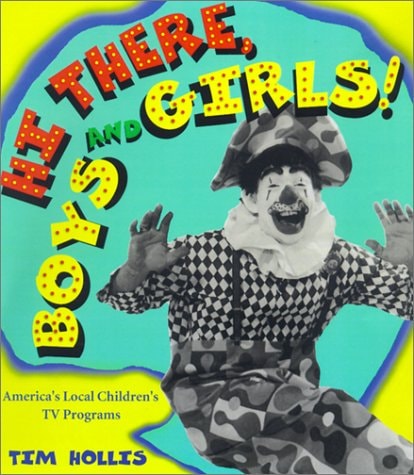

- Author
- Tim Hollis
- Publisher
- University Press of Mississippi
- Language
- English
- Year
- 2001
- Page
- 361
- ISBN
- 1578063957,9781578063956
- File Type
- File Size
- 30.2 MiB
From Booklist Local children's programming had its roots in radio, where it consisted mainly of storytelling by "uncle" hosts. When TV stations started broadcasting old Westerns and syndicated cartoons, the "host" pattern reemerged. Other genres arose: TV "school" settings, puppets, birthday parties. Romper Room and Bozo the Clown were strong franchised children's programs produced locally. Children's programs are not well researched, so this reference work is an initial effort in this area of popular culture.The author sets the scene in his 20-page history, discussing local programming from its beginnings through the early 1970s. The remainder of the volume is arranged alphabetically by state, and within each state, by city. Each station's history of children's programming is related in a conversational style. The vast majority of content deals with the personalities of the program hosts, including the local beginnings of national figures such as Captain Kangaroo, Shari Lewis, and Mr. Rogers. The length of each city's entry ranges from a quarter page to more than a dozen pages (Chicago, Los Angeles, New York). About 20 percent of the pages include a black-and-white photo (sometimes a page away from the related text). An end-volume bibliography lists the interviews, print, video, and Internet sources Hollis used to gather his facts.Partly because of a lack of adequate information, coverage is spotty. Spokane, Washington, is not covered well: no hosts (such as Cap'n Sid) identified, some stations that included children's programming (such as KXLY) not noted, no mention of Spokane's strong German-language programs for children (which also featured children), no mention of a popular children's talent show. Indeed, a major limitation of the work is the almost total lack of mention of children's talent variety shows.This work is a good start on the topic but is limited in scope. For large collections that specialize in television or popular culture. REVWRCopyright © American Library Association. All rights reserved Product Description Whatever happened to Bozo the Clown, to Aunt Norma, to Solomon C. Whiskers, those television celebrities who hammed it up between cartoons and contests during local kids' shows? In Hi There, Boys and Girls! America's Local Children's TV Programs, Tim Hollis tracks down the story of every known local children's TV show from markets across the United States. There have been many books about children's television on the networks, and such shows as Captain Kangaroo, Howdy Doody, and Sesame Street are legends in broadcasting. However, the local branch of children's programming has received much less attention. For every performer on the scale of a Captain Kangaroo or a Buffalo Bob, there were five or six local personalities who were just as beloved by their viewers--and sometimes even more so--since these local stars could be counted on for appearances at stores, children's hospitals, and shopping centers, where kids could meet them face-to-face. Anyone over the age of thirty who grew up with a TV set will remember at least one or two of these productions. Whether it was hosted by a cowboy character, a clown such as the one on the many-franchised Bozo shows, a policeman, a sea captain who showed Popeye cartoons, or one of the gentle and lovely ladies who presided over Romper Room, these hometown stars were some of the Baby Boomers' first friends. Although children loved them, these hard-working performers garnered less respect from the rest of the TV industry.Hi There, Boys and Girls! includes a capsule history of this programming from the earliest days of radio to the early 1970s, when a combination of social changes and broadcast regulations sent most of the hosts into retirement. Walt Disney once observed that while there is very little adult in a child, there is a lot of child in every adult. This book will bring back a flood of long-submerged memories for anyone who was a child during t
show more...How to Download?!!!
Just click on START button on Telegram Bot